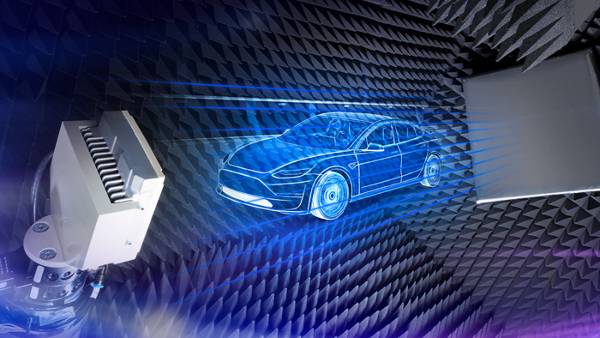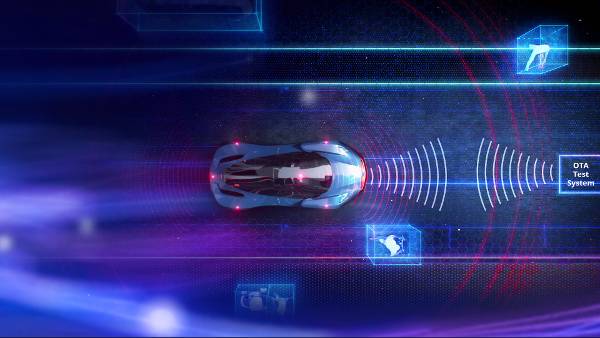Radar sensors play an important role when it comes to integrating intelligent solutions for assisted and autonomous driving in vehicles. dSPACE Automotive Radar Test Systems (DARTS) can efficiently ensure the correct functioning of sensors and developed application software in different phases of the development, production, and release process for sensors and vehicles as well as for aftermarket use.

What is DARTS?
dSPACE Automotive Radar Test Systems (DARTS) form a product family for testing radar sensors using automotive radar bands. With DARTS, radar sensors can be tested in the laboratory in clearly defined, reproducible scenarios. DARTS simulate object reflections – so called radar targets – that occur in road traffic at different distances, speeds, and sizes in real time. DARTS play a decisive role in the validation of radar-based driver assistance systems and autonomous vehicles throughout the entire value chain. Powerful devices are available for use in development and testing in the laboratory, for end-of-line tests during production, for the homologation of a vehicle, and for aftermarket testing.
Application areas
Powerful radar target simulators are available for development and test tasks.
Depending on the application and task, you can choose between scalable modules, desktop devices, and mobile devices. All DARTS are able to simulate radar echoes with the following characteristics: distance (signal delay), speed (frequency shift, Doppler including micro-Doppler), and size (radar cross section).
- Accurate over-the-air simulation of radar echoes in real time
- Particularly realistic tests of ADAS/AD applications, sensors, and vehicles
- Best-in-class range coverage, speed, and size simulation
- Precise testing and validation of all radar -based sensor types
- Easy setup of the scalable systems for all ADAS/AD applications
- An ideal choice for chip testing, R&D, end-of-line, and type approval
- Easy and efficient automation using a standardized protocol and interface
Key Benefits of the DARTS
Why consider DARTS for the development and validation of radar sensors? DARTS is based on cutting-edge technology that meets the highest demands.
dSPACE's radar test solutions have important, versatile features that ultimately determine the quality and reliability of the systems you develop:
Over-the-Air
The over-the-air (OTA) approach, in which a sensor is stimulated directly with its physical input variable such as radar, lidar, ultrasound, or light waves, has proven successful for this purpose. OTA testing offers the unique advantage of looking at the function and performance of all processing stages in their entirety – from the front end (lens, imager, antenna, RF receiver, etc.) to the output signal. The special charm of this solution: The component under test is used exactly as in its application – without any intervention or modification
Presicion
Reliability, precision, and stability of the functions are particularly important for high-frequency systems operating in the GHz range that are also used for safety-critical applications. For example, a preset frequency must be stable for the entire test period. This ensures highly accurate Doppler simulation and guarantees precise repeatability and reproducibility of a designated test scenario, for example, moving pedestrians. This is exactly what DARTS offer by means of high-quality components and sophisticated RF circuit technology.
Flexibility
DARTS are regarded as the radar target simulators with the smallest RF front ends in the world and are therefore ideally suited for dynamic angle simulations. The small size and low mass of the RF front ends offer almost unlimited possibilities in terms of test setups.
To sum it up: DARTS is based on cutting-edge technology that meets the highest demands.
Automotive Language
Continuous range coverage
Electromagnetic waves propagate with the speed of light, which results in an extremely short time interval between transmission and reception of a signal. The processing time of the radar signal in DARTS has to be in the same order to simulate targets close to the radar sensor. The DARTS product family`s dedicated design offers a low minimum distance (0.6 m) and also enables the simulation of large distance echoes (up to 1,000 m). The distance can be varied in small step sizes to ensure realistic simulation of moving objects. Besides this is the minimum distance that can be simulated also determined by the cable delay and the processing time. This means, the longer the cables, the larger is the minimum distance.
Other Outstanding Features
- Fully coherent generation of range, Doppler and radar cross section (RCS) as a measure for distance, speed, and size of the simulated objects
- True (single-sideband) Doppler spectrum for real-life signals
- Continuous real-time processing of radar signal waveforms
- Easy switching between radar bands: 23 – 26 GHz, 57 – 64 GHz, 75 – 82 GHz
- Any modulation format: pulsed, stepped frequency, FMCW, DCM, etc.
- Center frequency can be set freely according to radar under test (RUT)
- Doppler shifts up to ±100 kHz, equal to ±706 km/h
- Micro-Doppler with Doppler resolution of 0.007 km/h
- Output amplitude programmable across a dynamic range
- Automation via JSON-RCP protocol, standardized, industry-proven, light weight, and human readable
- Applied in numerous successful projects for real-time scenario generation
Advantages of Radar Target Simulation
- Particularly realistic tests of ADAS/AD applications
- Validation of the entire radar transmission channel
- Very fast and thorough tests
- Simple test setups
- Short commissioning
- Seamless integration into existing test environments
- Minimization of time to market
DARTS – Deep Dive

The Operating Principle of DARTS
All devices work according to the over-the-air principle: The real sensor is stimulated in real time during operation. DARTS receive the signal from a radar sensor, generate an internal echo, and return it to the sensor. Therefore, the radar sensor can be operated and tested exactly as in a real environment. To test the sensor in a defined way, extensive manipulations of the echoes are possible: The distance of an object or target is simulated by delaying the echo; the object size is simulated by changing the frequency and velocity, and by attenuating the reflected energy. To determine the azimuth angle, the receive and transmit modules can be placed and moved arbitrarily. Alternatively, a system with several receive and transmit modules can be set up. With a radar test bench, amechatronic extension solution from dSPACE, even continuous angle simulation is possible.

Simulation Possibilities
DARTS enable developers of ADAS/AD applications to test quickly, effectively, and thoroughly. Object detection scenarios such as adaptive cruise control (ACC), autonomous emergency braking (AEB), pedestrian detection, or cut-in/cut-out maneuvers can be realistically represented with the DARTS – especially for critical cases.

Tailor-Made Solutions
The DARTS family is particularly characterized by its excellent scalability: The number of echoes to be simulated can be increased by parallelization and with combinations, short- and long-range solutions can be expanded to particularly powerful complete solutions.

The mechatronic radar test bench with dynamic and continuous angle simulation lets you test radar sensors during closed-loop operation. dSPACE offers a complete range of turn-key products including for hardware-in-the-loop (HIL) simulation.

Automation
All DARTS products are ready to be used immediately for automated test procedures – No further software is needed.
Operation of automated test procedures is simple via the remote control by means of a connected PC or by uploading a test script to the DARTS – on which it is then executed directly.
No prior knowledge is required to use DARTS for test procedures.
Automation is supported by the following factors:
- Automation via JSON RPC protocol: standardized, industry-proven, light weight, and human-readable protocol
- Simple and straightforward integration into test environments: PC, dSPACE SCALEXIO real-time systems, and other real-time systems
- Self-sufficient test sequence control: Upload of a test script to the DARTS
- Ethernet communication via TCP or UDP
- Applied in numerous successful projects for real time scenario simulation
- Responds to realized target parameter with high accuracy
- Simple integration in Python, C, C#, MATLAB, ...
- Script examples and library available on request
DARTS – Technical Details
|
DARTS |
9020-S |
9030-M |
9030-MS |
9030-M/MS Multitarget |
9040-G |
9041-G |
9042-G |
9043-G |
9040-GT |
|---|---|---|---|---|---|---|---|---|---|
| Frequency range | 23 – 26 GHz or 57 – 64 GHz or 76 – 81 GHz | 23 – 26 GHz or 57 – 64 GHz or 76 – 81 GHz | |||||||
| Bandwidth | 3 GHz | 1 GHZ | 1 GHz | 1 GHz | 5 GHz | ||||
| Range | 0.6-6.8 m | 5.0-984 m | 1.8-984 m | 9.1-498 m |
2.8-300 m |
2.4-300 m |
1.8-300 m Four fixed, customer-specified |
1.3-300 m One fixed, customer-specified |
3.6-299 m |
| Speed | ± 700 km/h | ± 500 km/h | |||||||
| Dynamic gain range | 55 dB | 60 dB | 60 dB | 110 dB | 70 dB | 80 dB |
70 dB |
||
| Maximum gain | 7 dB | 20 dB | 20 dB | 20 dB | 13 dB |
18dB |
20 dB |
||
| Independent echoes | 1 | 1 | 1 | 4 - from one frontend | 1 |
2 - from one or two frontends |
|||
| Frontend concept | Monostatic or bistatic; single-cable converter |
Monostatic or bistatic; high bandwidth converter |
|||||||
DARTS - Product Family

Neue DARTS Features Q1/2024
The firmware update of our DARTS product family once again expands the possibilities for testing and stimulating radar systems:
- Radar data logging is now also possible with DARTS 9030-M(S).
- From now on, simulation parameters can only be changed during frame pauses. This enables an even more precise simulation of radar echoes in the test runs.
- DARTS can now also perform self-sufficient test sequence control as a supplement to external test control via the automation interface. For autonomous sequence control, the user loads their test scripts and scenarios onto the DARTS, which then runs them.














